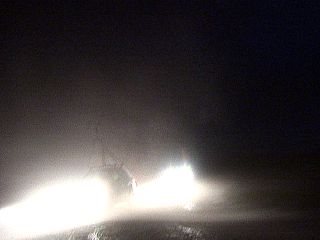Everyone I've met that has been in a tornadic circulation is somewhat changed by the experience. That is, chasing is never quite the same. Fear does this and it's associated with a real chemical release in our brain telling us
don't do that again. I had a good discussion with two people hit by a tornado on May 22, one was slightly injured when blown under the vehicle, also the glass was completely blown out which can be very dangerous. Seems we hear of someone getting in trouble during every major outbreak where mass participation is involved.
Chasing (for many) has been reduced to one simple goal, getting close to the debris cloud and turn on the camera. I've watched people do this and it's obvious the path to this objective is the only thing on their mind, the rest of the storm be dammed. That is, deal with the consequences when and if they arise. This approach certainly works most of the time when there is one center of circulation. I can't talk to those chasers consumed with this tactic, I doubt they will listen. For the others there are solutions and ways of playing the odds, at least until the lights go out.
The art of judging the storm by its structure is being lost, replaced by in vehicle radar. Unfortunately radar is seeing rain, bad things can happen in an updraft well before the rain lights it up on radar at the surface. For me it helps to segregate storms into types, what they are and what they are becoming. By now I hope most realize the old concept of LP to HP is but a process, nothing is steady state. I try to reduce the area of concern to what I'm dealing with, linear (flanking line before occlusion), or concentric rotating storms. Attica to Anthony 2004 was mentioned, what a beautiful example of the worst kind of situation. A giant rotating complex with tornadoes throughout. May 22 along highway 23 was a great example of both. The wall cloud circulation in the flank of the tornado north of Hoxie was very "approachable," if you will. The new wall cloud (as some call it) to the north was not, that whole complex was dangerous and very different from the event only minutes before. It amazes me how the atmosphere can create two totally different situations out of pretty much the same environment. The second storm was a huge rotating mass, the whole storm was the wall cloud and these are by far the most dangerous. Going into one of these is much like going into a cave with a monster; problem is, the entrances and exits change within minutes. Most tornadoes are individual updrafts; when the whole storm rotates these updraft circulations and attending RFD's can be swept up in the circulation and around the storm perimeter. This makes path prediction very difficult. Greensburg was one of the best examples of this convective behaviour as it morfed from a flanking line storm into a mass of rotation with circulations spinning up and occluding around the outside. I'll add, if you watch the time lapse radar of the storm David Drummond tangled with it had the same characteristics. It's my wish that chasers quit depending so much on the radar presentation and go back to watching the character of the storm they are entering. Multiple flanks, whole storm rotation, new updrafts or deep occlusions are all a clue to what may later complicate your chase. With gas prices hitting new highs group chasing is making a big comeback. Try assigning people to watch certain sectors of the storm during your time under a convective base and not just the center of the circulation. This mindset of treating secondary vorticies like they are freak events is unreasonable,
most major supercells do produce multiple tornadoes and we should be expecting them.
Also, trusting your well being to the location of a rotating wagon wheels (Threatnet), or the MDA's on level two displays is dangerous. These
shear markers often jump around from scan to scan. Better to key on the higher shear colors within a storm if you have Level II.
http://ams.allenpress.com/perlserv/?request=get-document&doi=
10.1175%2F1520-0434(1998)013%3C0304%3ATNSSLM%3E2.0.CO%3B2&ct=1#I1520-0434-13-2-304-T14
http://www.srh.noaa.gov/topics/attach/html/ssd98-23.htm
Seems to me that TVS circulations are often displayed too far NE of the ground truth circulation. Most likely because of storm tilt with height. As for the numbers assigned to these shear markers,
higher numbers don't always guarantee a tornado, but I think they make the location somewhat more dependable on Level II displays.
Gene Moore


